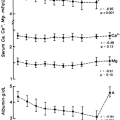CLINICAL ASSESSMENT OF CALCIUM HOMEOSTASIS
The clinical evaluation of normal and abnormal calcium homeostasis requires an accurate assessment of serum calcium and phosphate concentrations as well as the functions of the parathyroid glands and the effector systems regulating calcium homeostasis. Total serum calcium and phosphate measurements are usually reliable. Both dip-type and flow-through electrodes of improved quality are widely available for measuring serum ionized calcium and may be useful when changes in serum protein levels make the accurate estimation of ionized from total calcium levels difficult. Measurement of the serum ionized calcium concentration may also be helpful in cases of mild primary hyperparathyroidism, in which an elevation of serum ionized calcium is sometimes more readily detectable than one of serum total calcium concentration.
DIRECT ASSAYS OF CALCIUM-REGULATING HORMONES IN BLOOD
PARATHYROID HORMONE
Most of the immunoreactive PTH in the circulation represents inactive fragments of the hormone comprising the mid-molecule and carboxy-terminal portions of the molecule70 (see Chap. 51). The amount of biologically active PTH (1-84) in the blood represents <10% of the total immunoreactivity. The advent of specific and sensitive double-antibody (e.g., immunoradiometric or immunochemiluminescent) assays specific for intact PTH has largely supplanted the previously used mid-molecule and carboxy-terminal assays.71 Although these double-antibody assays were originally thought to recognize only the intact form of PTH, later studies have shown that they also detect variable amounts (10–25% or more) of additional forms of immunoreactive PTH.72 Nevertheless, these intact PTH assays permit reliable diagnosis of primary and secondary hyperparathyroidism when interpreted in the context of the simultaneously measured serum calcium concentration. Furthermore, in hypercalcemia due to nonparathyroid causes, intact PTH levels are generally frankly suppressed, greatly facilitating the differential diagnosis of hypercalcemia. The need seldom arises, therefore, to measure PTH by the older immunoassays or more cumbersome bioassays. Because high-quality assays for parathyroid hormone–related protein are also routinely available,73 measurement of urinary cAMP excretion is usually not required to diagnose parathyroid hormone–related, protein-mediated hypercalcemia of malignancy. An assay that appears to be specific for PTH (1-84) per se is under development.
CALCITONIN
The determination of the immunoreactive calcitonin level is most useful in screening patients suspected of harboring medullary thyroid carcinoma (MTC).74 In this setting, the calcitonin level is determined both before and after the administration of a secretagogue, such as calcium or pentagastrin. An abnormally large increase in the circulating level of calcitonin after penta-gastrin administration generally indicates that the patient harbors a C-cell neoplasm. The identification of the gene (the retoncogene) causing familial MTC and multiple endocrine neoplasia type 2 (MEN2)75 now permits the clinician to identify
obligate gene carriers by genetic means rather than relying solely on pentagastrin testing. How or to what extent serum calcitonin influences calcium homeostasis in normal humans is uncertain (see Chap. 53).
obligate gene carriers by genetic means rather than relying solely on pentagastrin testing. How or to what extent serum calcitonin influences calcium homeostasis in normal humans is uncertain (see Chap. 53).
Stay updated, free articles. Join our Telegram channel

Full access? Get Clinical Tree





